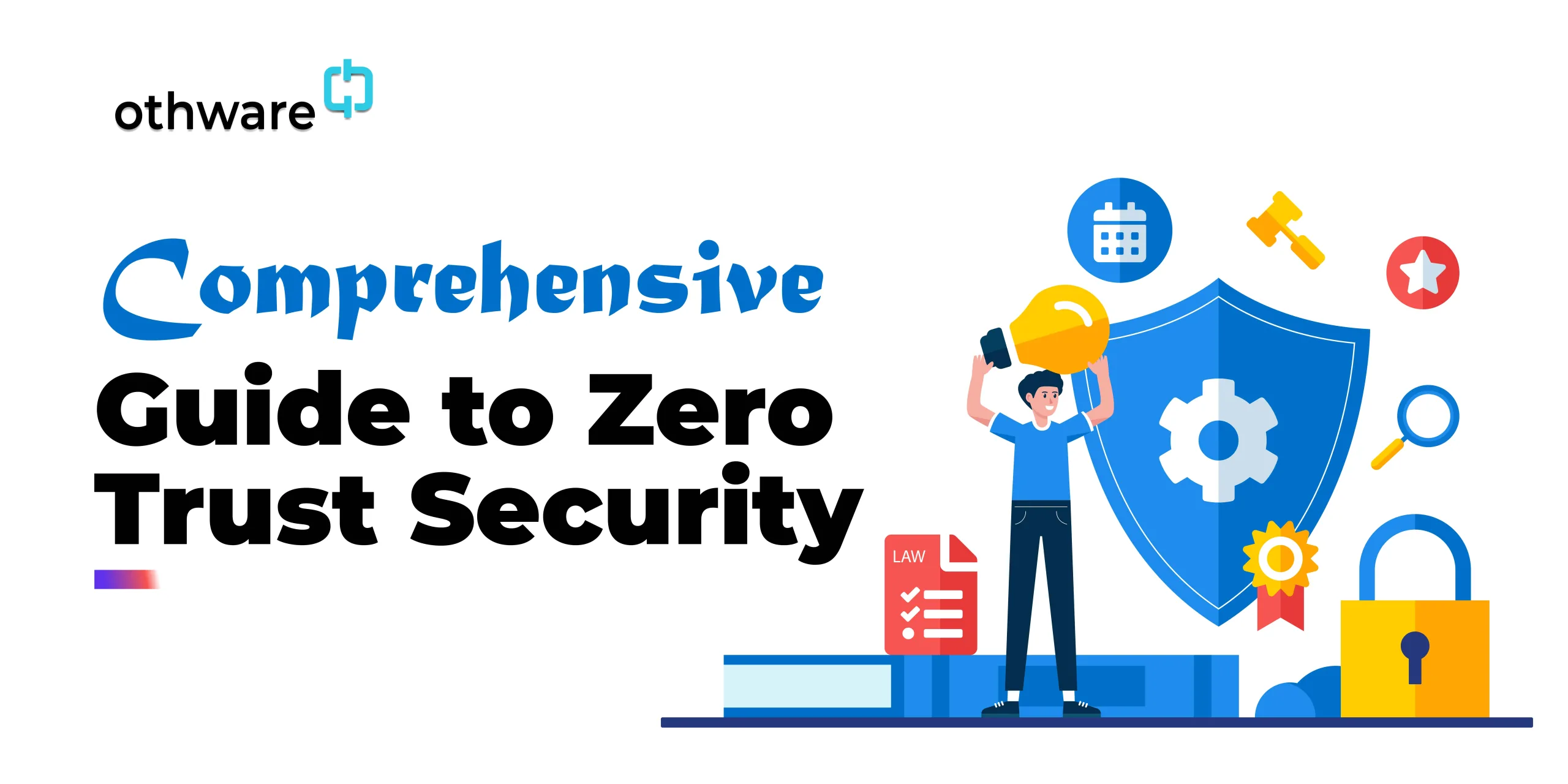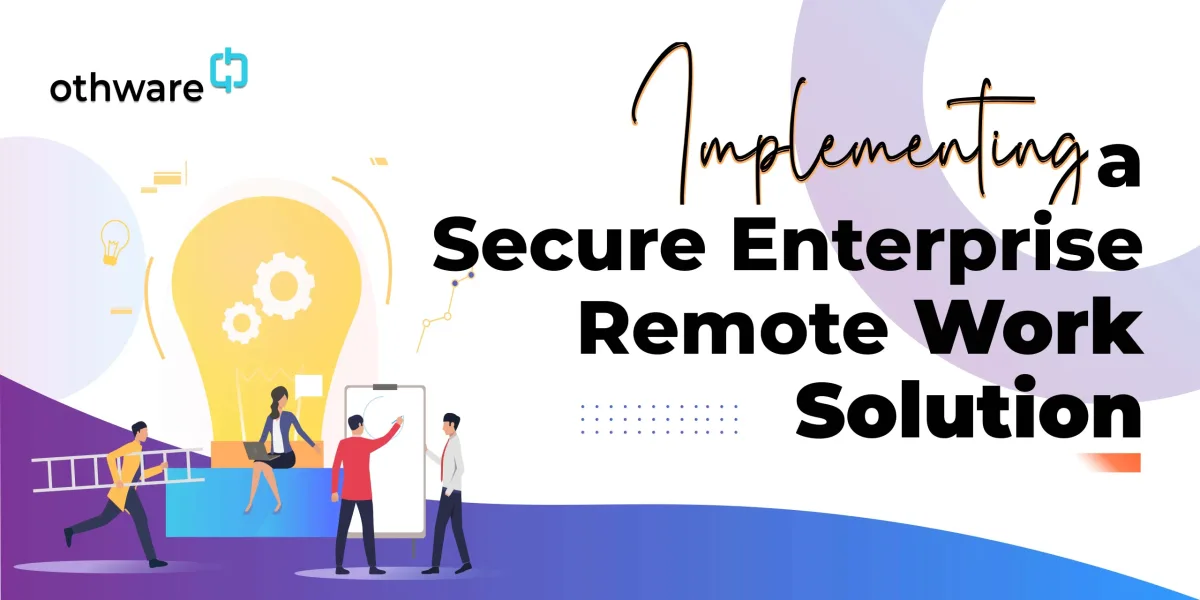
Comprehensive Guide to Zero Trust Security
Traditional security strategies are finding it difficult to keep up with an ever-changing digital ecosystem where cyber threats have become the norm. The outdated perimeter-based strategy for cybersecurity has become ineffective as a result of the rise of sophisticated cyberattacks. The ultimate solution, as we will discover in this article, is Zero Trust security.
Zero Trust Security is a revolutionary approach that redefines the way individuals, businesses and organizations protect valuable assets. By discarding the outdated notion of trust, Zero Trust provides a robust framework to safeguard organizations against cyber threats.
In this comprehensive guide, we will delve into the depths of Zero Trust Security. We will unravel its core principles, explore its practical implementation, and uncover its potential to reshape the future of cybersecurity.
Understanding Zero-Trust Security
Zero Trust is a revolutionary security approach that challenges the age-old assumption of “trust but verify.” Instead, it adopts the principle of “never trust, always verify” for every user and device attempting to access resources within the network. By assuming that no user or device can be trusted by default, Zero Trust forces a continuous verification and authentication process, drastically reducing the risk of unauthorized access.
To understand Zero Trust, imagine each user or device as an individual knocking on the door of your digital fortress. Instead of only checking their credentials at the entrance, Zero Trust requires each person to verify their identity and intentions at every step taken within the fortress. This way, an attacker is bound to face multiple barriers before gaining access to critical resources.
By adopting Zero Trust, organizations can embrace a proactive and layered security strategy. This means effective mitigation of potential security breaches and fortifying their overall defense posture. The power of Zero Trust lies in its ability to detect and thwart threats early in their lifecycle.
The Core Principles of Zero Trust Security
Principle 1: Verify and authenticate every user and device
The first fundamental principle of Zero Trust revolves around the verification and authentication of every user and device attempting to access the network. This involves implementing robust Identity and Access Management (IAM) solutions that ensure each user’s identity is verified and authenticated. This can be through multi-factor authentication (MFA), strong passwords, and other advanced authentication methods. Similarly, devices seeking network access must undergo rigorous validation processes to ensure their integrity and security posture. By enforcing strict user and device authentication, organizations can significantly reduce the risk of unauthorized access and identity-based attacks.
Principle 2: Apply strict access controls and segmentation
Zero Trust emphasizes the importance of granular access controls and network segmentation to minimize the potential attack surface. Rather than relying on broad, permissive access privileges, organizations should adopt a Principle of Least Privilege (PoLP) approach. This involves granting users and devices only the necessary permissions to perform their specific tasks. Network segmentation further enhances security by isolating critical assets, applications, and data into separate compartments. This way, even if one segment is compromised, the attacker’s lateral movement is restricted, limiting the potential damage and mitigating the overall impact.
Principle 3: Continuously monitor and analyze user and network behavior
Constant monitoring and analysis of user behavior, as well as network activities, is a crucial element of Zero Trust security. By leveraging advanced technologies such as User Behavior Analytics (UBA) and Network Traffic Analysis (NTA), organizations can identify anomalies and potential security breaches in real-time. These technologies establish a baseline of normal behavior for each user and device and raise alerts when deviations occur.
Implementing Zero Trust Security
Defining the network and asset boundaries
Implementing Zero Trust requires a clear understanding of the organization’s network and asset boundaries. This involves mapping out the critical assets, applications, and data that need protection and establishing precise perimeters around them. By defining these boundaries, organizations can create a strong foundation for implementing access controls and segmentation, ensuring that only authorized users and devices can interact with the designated resources. It is crucial to conduct a thorough assessment of the organization’s infrastructure and identify potential vulnerabilities or areas that require additional protection.
Role of identity and access management (IAM)
Identity and access management (IAM) plays a pivotal role in Zero Trust security. An effective IAM solution enables organizations to manage and control user identities, their permissions, and access privileges with precision. This includes implementing robust authentication mechanisms, such as multi-factor authentication (MFA) and biometrics, to verify the identities of users and devices. IAM solutions also facilitate the enforcement of least privilege principles, ensuring that users have access only to the specific resources required for their roles. By integrating IAM into the Zero Trust architecture, organizations can establish a strong foundation for secure access management.
Micro and Network segmentation
Micro-segmentation and network segmentation are key components of Zero Trust security that enable organizations to divide their networks into smaller, isolated segments. Micro-segmentation involves creating granular security zones within the network, where each segment has its own access controls and policies. This ensures that even if an attacker gains access to one segment, they are limited in their lateral movement and cannot easily compromise other areas. Network segmentation, on the other hand, involves dividing the network into separate subnetworks based on factors like department, function, or sensitivity of data. By segmenting the network, organizations can apply appropriate access controls and monitoring measures to each segment, reducing the overall attack surface and enhancing security.
Key Components of Zero Trust Security
User Authentication
Multi-factor authentication (MFA)
Multi-factor authentication (MFA) is a critical component of Zero Trust security when it comes to securing user authentication. MFA requires users to provide multiple forms of identification to verify their identities, typically combining something they know (e.g., a password), something they have (e.g., a mobile device), and something they are (e.g., biometric data). By implementing MFA, organizations significantly strengthen their authentication process, making it more difficult for unauthorized individuals to gain access. MFA adds an extra layer of protection, reducing the risk of password-related breaches and credential theft.
Implementing strong password policies
Strong password policies are essential for maintaining robust user authentication within a Zero Trust environment. Organizations should enforce password complexity requirements, encouraging users to create passwords that are difficult to guess and regularly prompting them to update their passwords. Passwords should be unique for each account and not shared across multiple platforms or systems. Additionally, organizations should consider implementing password management tools that enable the secure storage and generation of complex passwords, further enhancing security.
Biometrics and adaptive techniques
Incorporating biometric authentication and adaptive techniques can further strengthen user authentication within a Zero Trust framework. Biometric authentication relies on unique physical or behavioral traits of individuals, such as fingerprints, facial recognition, or voice patterns, to verify their identities. Biometrics offer a higher level of security than traditional password-based authentication, as they are inherently tied to an individual and difficult to replicate. Adaptive techniques analyze user behavior patterns and assess risk factors to dynamically adjust authentication requirements. For example, if a user is accessing sensitive data from an unusual location or exhibiting suspicious behavior, the system may prompt for additional verification steps. By leveraging biometrics and adaptive techniques, organizations can enhance authentication security while providing a seamless user experience.
Data Protection
Data encryption
Encryption is a vital tool in protecting sensitive data within a Zero Trust environment. It ensures that data remains secure even if it is intercepted or accessed by unauthorized individuals. Organizations should implement robust encryption algorithms to encrypt data both in transit (while being transmitted between systems or over networks) and at rest (when stored on servers or devices). This ensures that even if an attacker gains access to the data, it remains unintelligible without the corresponding decryption key. Encryption adds an extra layer of security, safeguarding data from potential breaches or unauthorized access.
Data loss prevention (DLP) solutions
Data loss prevention (DLP) solutions are crucial for maintaining data security and preventing data leakage within a Zero Trust environment. DLP solutions employ technologies and policies to monitor, detect, and prevent unauthorized transmission or disclosure of sensitive data. These solutions can identify and block attempts to transfer confidential information via various communication channels, such as email, instant messaging, or cloud storage. By implementing DLP solutions, organizations can proactively identify and mitigate potential data breaches, ensuring that sensitive information remains protected.
Data governance and compliance
Zero Trust has a significant impact on data governance and compliance efforts. By adopting a Zero Trust approach, organizations can enforce strict access controls, implement encryption, and deploy data loss prevention mechanisms, all of which contribute to a robust data governance framework. Zero Trust also aligns with various regulatory requirements and industry standards, such as the General Data Protection Regulation (GDPR) or the Health Insurance Portability and Accountability Act (HIPAA). Organizations that implement Zero Trust security measures are better equipped to meet data privacy and compliance obligations, minimizing the risk of penalties or reputational damage.
Network Security
Firewalls
Network security plays a crucial role in the Zero Trust era, and Zero Trust firewalls are essential components of a comprehensive network security strategy. These firewalls are designed to enforce strict access controls and policies based on user identity, device posture, and other contextual factors. Zero Trust firewalls provide granular visibility and control over network traffic, preventing unauthorized access and mitigating the risk of lateral movement within the network.
Network visibility and monitoring
Network visibility and monitoring are essential for effective security in a Zero Trust environment. By employing advanced monitoring tools and technologies, organizations can gain real-time insights into network activities, detect anomalies, and identify potential threats. Network visibility enables security teams to track user behavior, monitor network traffic, and identify unauthorized access attempts. With comprehensive visibility, organizations can respond quickly to security incidents, investigate potential breaches, and take proactive measures to prevent further risks. Continuous monitoring and analysis are critical to maintaining a secure network and ensuring the effectiveness of Zero Trust security measures.
Secure remote and cloud-based access points
With the rise of remote work and cloud-based services, securing remote and cloud-based access points is crucial in a Zero Trust environment. Remote access solutions should incorporate robust authentication methods, such as MFA, to verify the identities of remote users and ensure secure connections. Additionally, organizations should implement secure remote access protocols, such as virtual private networks (VPNs) or zero-trust network access (ZTNA) solutions, which provide encrypted tunnels for remote access while enforcing strict access controls. Cloud-based services should also be protected with appropriate security measures, including encryption, access controls, and continuous monitoring, to maintain data confidentiality and integrity.
Conclusion: Challenges in adopting Zero Trust Security
While Zero Trust security offers numerous benefits and improved defense against modern threats, its adoption is not without challenges.
Cultural Shift and Organizational Buy-In
One of the primary challenges in adopting Zero Trust is the cultural shift it requires within organizations. Zero Trust represents a departure from traditional security models, and it may encounter resistance from employees and stakeholders accustomed to more permissive access approaches. Convincing stakeholders to embrace the “never trust, always verify” mindset and invest in the necessary security infrastructure can be a daunting task. Organizations must actively communicate the benefits of Zero Trust, conduct training and awareness programs, and garner support from top-level executives to foster a security-first culture and ensure broad organizational buy-in.
Complex Implementation and Integration
Implementing Zero Trust is not a one-size-fits-all endeavor. Each organization’s IT infrastructure and security requirements are unique, and the complexity of implementing Zero Trust can vary significantly based on their size and technology landscape. Integrating various security technologies, such as IAM solutions, access control mechanisms, and network segmentation, requires careful planning and coordination. Migrating from legacy systems to a Zero Trust architecture can be challenging, and it is crucial to ensure that existing business processes and workflows are not disrupted during the transition. Organizations may need to seek expertise from cybersecurity professionals and consultants to navigate the complexities of Zero Trust implementation successfully.
Balancing Security and User Experience
While Zero Trust significantly enhances security, it can potentially impact user experience if not implemented thoughtfully. Stringent authentication measures and continuous verification may increase user friction, leading to frustration among employees and customers. Finding the right balance between robust security and seamless user experience is essential. Employing technologies like single sign-on (SSO), adaptive authentication, and user-friendly MFA methods can help strike a balance between security and convenience. Organizations should prioritize user feedback and continually optimize the Zero Trust framework to provide a frictionless and secure user experience.

Passionate about tech, a better writer than talker. Also a Content writer @ Othware.



